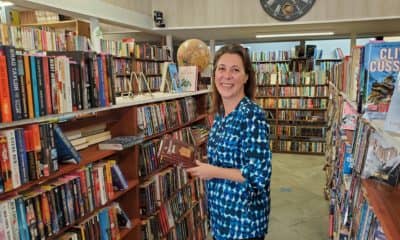Thrive
Rays development agreement debate details benefits, concerns

City Councilmember Ed Montanari, channeling former President Ronald Reagan, said his goal for Thursday’s much-anticipated discussion on the historic Gas Plant District’s $6.5 billion redevelopment was to “trust but verify.”
Montanari and his colleagues expressed thoughtful, researched and sometimes pointed concerns regarding a generational project that stakeholders hope will atone for past grievances while fostering a bright future. Former city officials displaced thousands of Black residents and businesses to build Tropicana Field and its sprawling parking lots; the Tampa Bay Rays and Hines development team plans to transform it into a thriving mixed-use community anchored by a new ballpark.
Thursday’s nine-hour meeting offered city council members their first opportunity to collectively debate the development agreement’s merits after several months of negotiations between the developers and Mayor Ken Welch’s administration. Those will continue, as administrators asked to postpone a May 23 discussion focused solely on the stadium about midway through the extensive meeting.
“I fully expected these types of questions because this is the biggest issue we will ever vote on as a body,” Welch said at the conclusion. “I think we can act on suggestions … that will make this a better set of agreements for us moving forward.”

An aerial view of the redevelopment. All renderings provided.
Several new project renderings drew near-unanimous praise. A revitalized and prominent Booker Creek was oft-discussed and celebrated. The development team said widened, pedestrian-friendly streets would reconnect predominantly Black surrounding neighborhoods and increase environmental sustainability.
Renderings showed 16th Street South as a bustling corridor lined with shops and colorful mixed-use buildings. Councilmember Copley Gerdes noted the transformation was a prominent community request and that it made his “heart happy” to see it become a focal point. One of several public plazas will feature a circular structure – shown with new City Connect uniform logos – at the site of a former gas storage container.
Dawn Gunter, managing director for architectural firm Gensler, said intentional design aspects would stoke curiosity about the site’s history. “Everything that we do, we want to overlay with stories,” she said.

The project features several public plazas and gathering spaces.
Everald Colas, founding principal of Storyn Studio for Architecture, explained that residents could accomplish daily tasks without leaving the walkable district. They could drop their kids off at an onsite daycare center, take a lunch break in one of the many “pocket parks,” have dinner at one of the restaurants or pick up food from its grocery store.
Job creation was another project highlight. Rays President Brian Auld said no other large employer would commit to calling St. Petersburg home for the next 30 years.
“That fact that this creates 11,000 ongoing, full-time jobs is so important,” Gerdes said. “That is ridiculous. That is a game-changer.”
The project will provide 1,250 affordable and workforce housing units, with 600 onsite. The Rays/Hines will dedicate at least 200 to people earning less than 80% of the area median income.
Amy Foster, housing development administrator, stressed that those were minimum requirements. She also noted that the Gas Plant once featured about 300 homes, and the project will double that number with high-quality units.
“I also want to remind you that affordable housing doesn’t happen in a vacuum,” Foster added. “This site will bring in economic activity that raises wages, impacting generations to come.”

The redevelopment will reimagine the 16th Street South corridor.
However, the administration and development team heard detailed concerns regarding penalties for failing to meet housing goals and ambiguous agreement language. Councilmember Richie Floyd wanted to ensure affordable units are not solely in “one corner.”
He and his colleagues want to mandate apprenticeship participation in vertical construction rather than more menial infrastructure jobs. Floyd also expressed dismay that the city may have to provide additional affordable housing subsidies.
“That’s frustrating for me because it seems like this deal guarantees us affordable housing,” he said. “But from what I’m hearing, that is not the case at all.”
Councilmember Lisset Hanewicz said the city should not spend $142 million on infrastructure, including a $12 million lift station, since it is not retaining ownership. Administrator Rob Gerdes said that is common practice for expansive redevelopment projects.
Hanewicz and others want the Rays to provide $50 million in community benefits upfront. “We don’t know when they’re going to deliver,” she said.

Booker Creek features prominently in project plans.
While Councilmember Brandi Gabbard appreciated the inclusion of a grocery store, she asked why it was not part of the minimum development requirements. She also questioned the lack of a concrete timeline for that and other integral project aspects, like a conference center.
“Frankly, for the Tampa Bay Rays to build a new stadium without these surrounding uses would be a complete disaster,” Gerdes said. “We are relying on their self-interest. It is their plan to do it in Phase A.”
Ensuring the remains of those buried at the former Oaklawn Cemetery, now under one of the Trop’s parking lots, are properly laid to rest is a project priority for Council Chair Deborah Figgs-Sanders. She also wants to move the first official development “check-in” from 2035 to 2030.
Figgs-Sanders is one of many stakeholders who would like to see the redevelopment provide homeownership opportunities. However, she expressed confidence that city officials would continue their “phenomenal job” of addressing housing needs.
“Too often these days, we debate complicated, nuanced issues as if they are part of a zero-sum game,” Auld said. “This (project) is the product of some of the most thoughtful and caring people in the world working together to do something special.”

A before and after view of the Tropicana Field site.








S. Rose Smith-Hayes
May 15, 2024at7:06 am
Correction: We were promised new homes, apartments and businesses and jobs if we moved from the GasPlant area. There was No discussion about a Baseball Stadium. The land lay vacant for years before someone decided, ‘oh we can build a baseball stadium’. There was no team when they built the stadium. All the promises made to residents were thrown into the trash. Then they promised jobs for former residents and their descendants once the stadium was built. A lot of lies and false promises.
They cannot fix what they broke and no one expects anything to be recreated, however, they cannot ever make up for the harm done.
Why did they Not allow Taxpayers to vote? It is too late now, ground must break by November 2024.
Drew
May 13, 2024at10:40 am
Let the taxpayers of St Pete and Pinellas vote on it.
Why did the council obstruct a previous vote?
Why don’t they want to hear the voice of the people who will be paying for this boondoggle?
Velva Lee Heraty
May 11, 2024at6:53 pm
My experience with the city while Spa Beach Park was being pirated and the new pier considered, was one of deception. For example, while promoting the billowing art work nothing was ever mentioned about the stanchions supporting it being six stories tall, nor the outrageous football field size, nor the glaring lights, nor the garish colors. The other deception was the vote for the new pier. After many time-consuming city meeting with residents and an official vote, the administration did not honor the people’s choice. My biggest fear about this project is what happened to the budget of the new pier. Not only was it not the one residents chose, it ran 60 million over budget. I attended many council meetings and was shocked at the stream of financial requests, many of the vague, that got immediately approved. Personally I’m still looking for where that sixty million went as the new pier, regardless of hype, does not reflect that budget. I believe history is repeating itself with this self-serving deal.
Lauren
May 11, 2024at3:03 pm
This entire plan/idea is a pipe dream and won’t end well. Let the people vote. If the City Council, the Mayor and the rest are so confident it’s a great deal, let the people vote.
Alan DeLisle
May 11, 2024at6:55 am
Let me get this right:
The Council is going to support spending over a billion dollars of tax payers money and rely on developer “self interest.” And if the Council thinks this Agreement even comes close to assuring 11,000 jobs, they are living on another planet. It doesn’t assure 1 job. Developer “self interest” can be a horrifying ride for a city. Ask one simple question: if the developer “intends” to go all these things, then why is it not in the agreement?
St Pete, you are walking off a cliff. Council, you should be furious that you have been handed this mess and residents even more.
Steven Brady
May 11, 2024at6:33 am
Have people not learned over the many decades that these deals never work out for the local governments and their Taxpayers?
The idea that people would come here or move here to be near a sports team is a complete fiction. Think about it from your own experience. Have you ever met anyone who has done this? You’re not alone. No one has.
Nowadays it’s all about TV revenue anyway.
Philip
May 10, 2024at5:04 pm
In a prior article Anne Fritz statement to the City Council was not the whole truth. The City may have a Net Worth of $1.5 billion but it is less than honest for her to imply that these funds are all available for use to pay for the stadium project. Most of the assets the City owns are buildings, infrastructure, water and sewer plants, the airport, port, public safety vehicles (fire trucks and police vehicles) etc.. that the City can not sell since they are needed for operations. In addition fund balance spending is restricted by various commitments, legal requirements, federal and state legal requirements, restrictive covenants those imposed by City Council and other restrictions. This reduces the funds actually available.
Tell Anne Fritz to be HONEST with the taxpayers and let us know how much “Net Worth” is actually available by each governmental and propriety fund. Be assured it is considerably less than than $1.5 billion !!!